Cancún, Quintana Roo 作者: 来源: 发布时间:2021-11-16
1.Population and Area
Pop: 743,626 (city)
Area: 1,978.75 km2
Elev: 10 masl
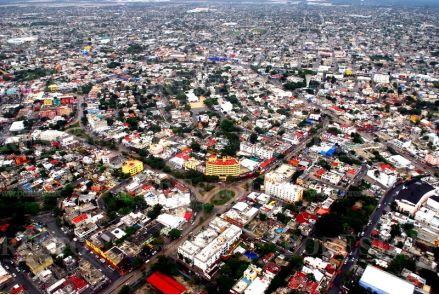
Ciudad del Carmen location in Mexico within the state of Campeche
https://goo.gl/maps/8Yn9oojFndNbnfxb6
2. Natural geography
Nature and weather
Coastal zone
The coastal area is a strip of white sand that runs along the coasts of this entire municipality and is the main tourist attraction of the city. From north to south we find public beaches from Puerto Juárez (Playa del Niño, or Playa Niños) to the Hotel Zone, where there are nine public beaches with designated accesses along the 22 km of the island: from km 0 to 22 : Las Perlas Beach, Langosta Beach, Tortugas Beach, Caracol Beach, Chac Mool Beach, Marlin Beach, Ballenas Beach, Delfines Beach and Nizuc Beach.
Access to the remaining strip of beaches has been restricted by the various hotel chains, so other points can only be accessed by walking on the same beach from any of these accesses.
Fauna
An interesting fact is the case of the Quiscalus mexicanus bird, better known as the carrot, pich or cau. This black bird has become a pest throughout the city due to its great adaptability and habits. In close contact with man, the Quascal has appropriated numerous areas for its nesting, and it is common to see dozens of flocks of caucus fly at twilight and to hear its sounds along Tulum Avenue (and even at the international airport). strident songs before falling asleep on the trees of the ridges.
There are also animals such as the white-tailed deer - in danger of extinction -, tapir, tepezcuintle and boa, among others.
Köppen Classification: Tropical Savanna Climate
Tropical savanna climates have monthly mean temperature above 18°C (64°F) in every month of the year and typically a pronounced dry season, with the driest month having precipitation less than 60mm (2.36 in) of precipitation. In essence, a tropical savanna climate tends to either see less rainfall than a tropical monsoon climate or have more pronounced dry seasons than a tropical monsoon climate. Tropical savanna climates are most commonly found in Africa, Asia and South America. The climate is also prevalent in sections of Central America, northern Australia and North America, specifically in sections of Mexico and the state of Florida in the United States.
The Köppen Climate Classification subtype for this climate is "Aw". (Tropical Savanna Climate).
The average temperature for the year in Cancun is 81.1°F (27.3°C). The warmest month, on average, is August with an average temperature of 85.5°F (29.7°C). The coolest month on average is January, with an average temperature of 75.4°F (24.1°C).
The highest recorded temperature in Cancun is 102.0°F (38.9°C), which was recorded in June. The lowest recorded temperature in Cancun is 49.1°F (9.5°C), which was recorded in March.
The average amount of precipitation for the year in Cancun is 51.2" (1300.5 mm). The month with the most precipitation on average is October with 11.1" (281.9 mm) of precipitation. The month with the least precipitation on average is April with an average of 1.1" (27.9 mm). In terms of liquid precipitation, there are an average of 111.9 days of rain, with the most rain occurring in October with 16.8 days of rain, and the least rain occurring in April with 3.9 days of rain.
https://www.weatherbase.com/weather/weather-summary.php3?s=184767&cityname=Ciudad+del+Carmen%2C+Campeche%2C+Mexico&units=
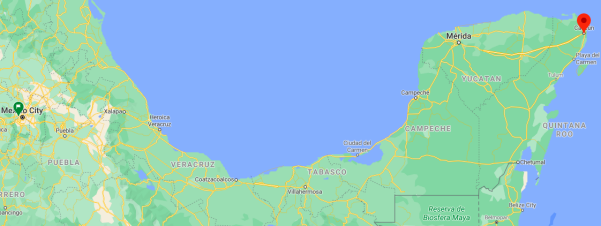
Getting there and around
Get there
By air – Cancun’s international airport is one of the busiest airports in Mexico, receiving frequent flights from the US, Canadian and European cities. From Mexico, you can fly to Cancun from Mexico City. The airport is 9 miles (16 km) south west from the city center and 6 miles (10 km) from the hotel zone. Ground transportation options, including taxis, rental cars and shuttles, are available from the airport.
By car – Driving to Cancun from Mexico City is recommended only if you have a good reason to go by road – for example, you want to stop and see places on the way; the drive from the capital to Cancun takes 24-30 hours and will require at least one overnight stop en route. A fast and efficient toll road connects Cancun to the colonial city of Merida, and there is an excellent road network around the Yucatan region enabling you to explore this unique and vibrant region of Mexico beyond the commercial beach resorts of Cancun and Riviera Maya.
By bus – You can travel to Cancun on a luxury bus from Mexico City – but the trip will take around 24 hours. Flying is the most sensible way to get to Cancun, unless you are on a budget and don’t mind the wait (and want to see the sights along the way).
https://www.mexperience.com/travel/beaches/cancun
Car Rental – To explore Mexico’s provincial towns and cities—including its beach locations and the scenery and attractions near them— consider renting a car for your visit. Having your own car will give you more flexibility than using public transport options and, in some cases, offer you access to places which are otherwise difficult to visit without the use of a car.
COVID19 – International entry into Mexico from United States
Allowed for: All visitors arriving by air. Mexico land borders are closed to non-essential travel
Restricted for: There are no current restrictions.
Get around
Local Buses – Local buses run a 24 hour service up and down the main Avenida Kukulcan; they are regular, clean, comfortable and very efficient; they are also air-conditioned and very inexpensive. You can also ride executive style minibuses and vans to nearby places like Playa del Carmen, Tulum, Chichen Itza; these options work out considerably less expensive than hiring a taxi to these areas.
Taxis – Taxis from Cancun Airport into town or other destinations can be quite expensive compared to comparable rides in other parts of Mexico. Check prices before getting in. In most of Mexico’s beachside towns and cities are not metered, so agree your price before you get in. Taxi travel is very affordable in Mexico, in comparison to the USA, Canada and Europe, and so provides a viable means of public transportation in Mexico. Your hotel can arrange taxis for you; some post their rates on a board in the lobby; taxi hotel rates are usually higher than cabs you hail off the street. If you speak Spanish, you will have a distinct advantage and be able to negotiate a price with the driver.
Warning About Mopeds – Mopeds can zip you around Cancun, but beware – they can be dangerous too. You may want to consider a safer alternative (like an open air Jeep) which will be more expensive, but safer.
Uber is expanding rapidly across Mexico and now offers services in cities across the country, including: Mexico City, Toluca, Cuernavaca, Puebla, Querétaro, León, Aguascalientes, San Luis Potosí, Guadalajara, Monterrey, Hermosillo, Tijuana, Mexicali, and Mérida. Uber has been adding Mexican cities to its network every year, check for availability when you arrive at your destination in Mexico.
Cabify and Didi are also developing and currently operate in cities including Mexico City, Toluca, Monterrey, Puebla, Querétaro and Tijuana. Check for availability in the city you are visiting.
These services offer people with smartphones a way to book a cab through a mobile app for a pre-agreed price. Fares are comparable with Sitio type cabs, and sometimes trade at a premium to this when local demand increases.
https://www.mexperience.com/travel/beaches/cancun
3. ECONOMY
GDP: 98,882 M MXN (2010)
https://imco.org.mx/ciudades2010/ciudades/36_Cancun.html
4. Industry characteristics
Tourism
The tourism sector is the main source of income for the city and the municipality, which makes the engine of the economy of Benito Juárez:
In Cancun there are 181 hotels with 35,023 rooms and 543 restaurants. (Dec 2015).
3,004,802 visitors went to Cancun in 2007, on an average of 190 daily flights (Dec 2009)
2,761,400 visitors went to Cancun in 2013, being the 63rd city with the most international tourists
Of all the tourists who visit Cancun, 49.6% come from Mexico, the second place corresponds to the United States with 35.7% .39
The annual economic income in Cancun for tourism is $ 3,072.21 million dollars. (January-December 2007).
The average spend per annual visitor in Cancun alone is $ 1,028.84. (January-December 2007).
Most hotels offer all-inclusive packages, to keep them in this area, allowing prices to rise. They generally have their own Marina services (water sports and entertainment) diving, snorkeling, food and drinks in general.
Cancun has the most varied nightlife, more than 10 discos, are grouped in an area known as Party Center, in the heart of the Hotel Zone.
It is the main tourist destination in the Caribbean and in all of Latin America, surpassing Brazil, Punta Cana, Puerto Rico, Bahamas or Buenos Aires, with 10 million tourists making trips to Cancun every year.
Tourism is also encouraged by the inhabitants of Cancun themselves locally. The people of Cancun have the opportunity to enjoy the so-called "day-passes" in the hotels that offer them, at much lower prices and that are exclusive for local people.
The people of Cancun also enjoy discounts in almost all kinds of tourist activities simply for being inhabitants of the municipality.
Other economic activities
Although tourism is the economic base of the city, the fishing sector is another important activity, due to the coastline that Cancun has. Fishing is concentrated in the Puerto Juárez area, which is classified as a moderately equipped port. It has a reception center with a capacity of 1-10 tons / day. Currency exchange is generated from the intense tourist activity, since this service is offered along the Kukulcán Boulevard and in the city center in different exchange houses. Commerce is concentrated in the squares and in the city center, as well as in the markets of the suburbs.
Key project: UN Habitat announces project for Cancun
UN Habitat announced this Wednesday that it is working with the authorities of Quintana Roo in the Project "Parque de la Equidad", which contemplates the development of a linear park in more than 16 kilometers that represent 89 hectares of space public and 2,064 hectares of area of influence in the Metropolitan Zone of Cancun.
The project, UN Habitat reports, seeks to reverse the conditions of socio-spatial segregation in Cancun and integrate urban areas of intervention into urban development. In addition, the plan will define urban actions aimed at improving the conditions of infrastructure, services and equipment in the area.
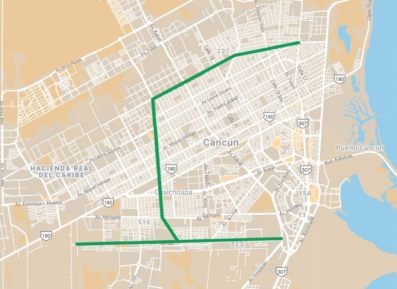
The project is expected to directly benefit about 200,000 people throughout the area of influence of Parque de la Equidad and in general throughout the city of Cancun. This project will reverse the lack of public spaces and green areas in the city and will reduce the conditions of urban segregation and social inequality in the city.
The Equity Park will be a safe, inclusive, accessible, green and quality space for the entire population, the UN subsidiary on ecology points out this day, because the park will also reduce the social gaps that predominate between the different Cancun superblocks.
UN-Habitat works together with the Strategic Projects Agency (AGEPRO) of the state of Quintana Roo with the support of Fundación Hogares to develop this project. Likewise, it seeks to collaborate with strategic local actors (public sector, universities, professional associations, businessmen, groups and civil society) to strengthen the scope of the project and achieve the meaningful participation of all.
https://lucesdelsiglo.com/2020/08/05/onu-habitat-anuncia-proyecto-para-cancun
5. Attractions
Cancun’s Beaches

The choice to develop Cancun as a tourist atrraction was due in no small part to its dreamy tropical beaches. However hurricane Wilma in 2005 swept away many of the tourist beaches, leaving behind thin strips of sandy shore where before there were wide bands of beach area. There have been efforts to reconstruct the beaches and replace the sand, but human engineering can’t match that of mother nature. Resorts which once could boast ample beachfronts have tried to compensate for the diminished sand by adding pools and gardens to their properties to enhance the ambience and provide outdoor ocean-facing facilities. You can still enjoy a wonderful experience in Cancun; the waters are still turqoise and picturesque and the destination offers a wide variety of amenities which extend beyond beach life. If you absolutely must have an ample beach to walk on, sunbathe and swim from, consider nearby Playa del Carmen Cozumel, Isla Mujeres and Tulum.
‘Jungle’ Tour on Water
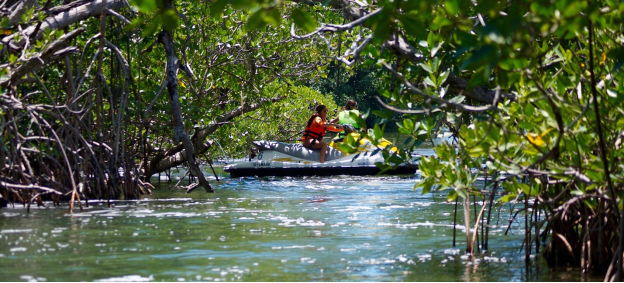
Ride through Cancun’s mangrove estuaries on a small motorized boat, leading out into Mexico’s Caribbean sea and reefs. You rent your own boat, and see the sights at your own pace (payment is by the hour). You can stop your boat and dive into the shallow waters to snorkel around the reefs and local marine life there. The operators provide snorkeling equipment and refreshments for you to take with you, included in the price. It’s a great way to see this magical part of the world!
Xel-Ha National Park
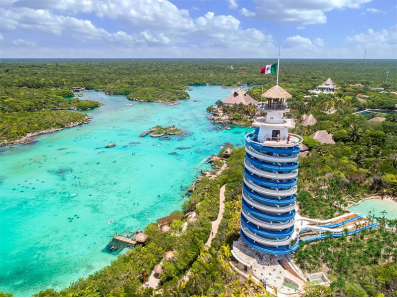
Day-trips to Xel-Ha are readily available and very convenient from Cancun. Xel-Ha is a national park which has been converted into a water theme park built around a collection of natural lagoons and inlets. The park offers a range of water activities, primarily based around snorkeling, although you can also float down the river in a ring, dive under water without tanks (they connect hoses to a helmet) and swim with dolphins (this costs extra and space is limited, so arrive early if you want to do this). There are also five restaurants and a bar where you have unlimited food and drink if you paid the all-inclusive price.
https://www.mexperience.com/travel/beaches/cancun
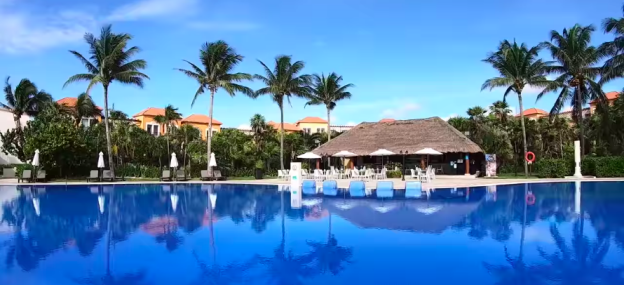
Staying at CANCUN ALL-INCLUSIVE RESORT during COVID-19
https://youtu.be/jP4j6VZOsrA
6. History
As documented in the earliest colonial sources, Cancún was originally known to its Maya inhabitants as Nizuc meaning either "promontory" or "point of grass". In the years after the Conquest, much of the Maya population died off or left as a result of disease, warfare, piracy, and famines, leaving only small settlements on Isla Mujeres and Cozumel Island.
The name Cancún, Cancum or Cankun first appears on 18th-century maps. The meaning of Cancún is unknown, and it is also unknown whether the name is of Maya origin. If it is of Maya origin, possible translations include "Place/Seat/Throne of the Snake" or "Enchanted Snake". Snake iconography was prevalent at the pre-Columbian site of Nizuc.
When development of the area as a resort was started on January 23, 1970, Isla Cancún had only three residents, all caretakers of the coconut plantation of Don José de Jesús Lima Gutiérrez, who lived on Isla Mujeres. Some 117 people lived in nearby Puerto Juárez, a fishing village and military base.
Due to the reluctance of investors to gamble on an unknown area, the Mexican federal government financed the first nine hotels. The first financed hotel was a Hyatt, Cancún Caribe, but the first hotel built was the Playa Blanca, which later became a Blue Bay hotel. It is now named Temptation Resort. At the time it was an elite destination, famous for its virgin white sand beaches.
The city began as a tourism project in 1974 as an Integrally Planned Center, a pioneer of FONATUR (Fondo Nacional de Fomento al Turismo, National Fund for Tourism Development), formerly known as INFRATUR. Since then, it has undergone a comprehensive transformation from being a fisherman's island surrounded by virgin forest and undiscovered shores to being one of the two most well-known Mexican resorts, along with Acapulco. The World Tourism Organization (WTO), through its foundation UNWTO-Themis, awarded the Best of the Best award "for excellence and good governance" to the Trust for Tourism Promotion of Cancún on February 3, 2007. This award ensured Cancún the ongoing support of the Department of Education and Knowledge Management of the WTO.
Most 'Cancunenses' are from Yucatán and other Mexican states. A growing number are from the rest of the Americas and Europe. The municipal authorities have struggled to provide public services for the constant influx of people, as well as limiting squatters and irregular developments, which now occupy an estimated ten to fifteen percent of the mainland area on the fringes of the city.
7. Other Information: Hurricane Wilma in Cancun
Hurricane Wilma was the most intense tropical cyclone ever recorded in the Atlantic basin, and the second-most intense tropical cyclone recorded in the Western Hemisphere, after Hurricane Patricia in 2015. Part of the record-breaking 2005 Atlantic hurricane season, which included three of the ten most intense Atlantic hurricanes ever (along with #4 Rita and #7 Katrina), Wilma was the twenty-second storm, thirteenth hurricane, sixth major hurricane, fourth Category 5 hurricane, and the second-most destructive hurricane of the 2005 season. A tropical depression formed in the Caribbean Sea near Jamaica on October 15, headed westward, and intensified into a tropical storm two days later, which abruptly turned southward and was named Wilma. Wilma continued to strengthen, and eventually became a hurricane on October 18. Shortly thereafter, explosive intensification occurred, and in only 24 hours, Wilma became a Category 5 hurricane with wind speeds of 185 mph (298 km/h).
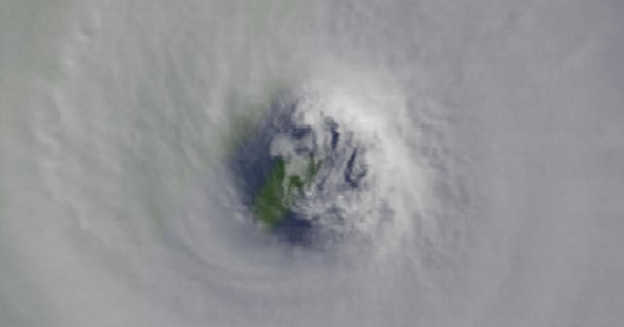
Hurricane Wilma’s eye over Cozumel island, in front of Cancun
Across the Yucatán peninsula, Hurricane Wilma dropped torrential rainfall, inundated coastlines with a significant storm surge, and produced an extended period of strong winds. The hurricane lashed parts of the Yucatán peninsula with hurricane-force winds gusts for nearly 50 hours. On the Mexican mainland, a station in Cancún recorded 10–minute sustained winds of 160 km/h (100 mph), with gusts to 212 km/h (132 mph) before the anemometer failed; gusts were estimated at 230 km/h (140 mph). The gust in Cancún was the strongest ever recorded in Mexico. The prolonged period of high waves eroded beaches and damaged coastal reefs.
Across Mexico, Wilma killed eight people – seven in Quintana Roo, and one in Yucatán. Throughout Mexico, Wilma's damage was estimated at $4.8 billion (MXN, US$454 million), mostly in Quintana Roo, where it was the state's costliest natural disaster. The hurricane resulted in $13.9 billion (US$1.3 billion) in lost economic output and earnings, 95% of which was related to lost tourism revenue. Wilma damaged 28,980 houses in Mexico, and destroyed or severely damaged 110 hotels in Cancún alone. In the city, about 300,000 people were left homeless. The water level in Cancún reached the third story of some buildings due to 5 to 8 m (16 to 26 ft) waves, in addition to the storm surge. About 300 people who were from Great Britain had to be evacuated when their shelter flooded in Cancún, while the Americans were left there by the United States. The hurricane also caused significant damage in Cozumel and Isla Mujeres. About 300,000 people lost power in Mexico. The storm also damaged 473 schools.
Flooding damaged houses in low-lying areas of eastern Yucatán state. The primary highway connecting Cancún and Mérida, Yucatán was impassible after the storm due to floods. Across Mexico, Wilma damaged 490 km2 (190 sq mi) worth of crops, majority of which was in Yucatán state. Across the Yucatán peninsula, the hurricane downed about 1,000,000 acres (400,000 ha) of trees.
https://en.wikipedia.org/wiki/Hurricane_Wilma
8. Contact Information
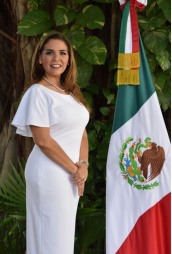
City Mayor: Mara H. Lezama Espinosa
Contact number: +52 (881) 28 00 Ext. 9000
Govt. Office Address: Palacio Municipal Planta Alta, Av. Tulum No. 5 Sm. 5 Cancún, Quintana Roo
Facebook: https://www.facebook.com/MaraLezamaOficial
Twitter: https://twitter.com/MaraLezama
Website: https://cancun.gob.mx
E-mail: secretariaprivadabj@gmail.com
